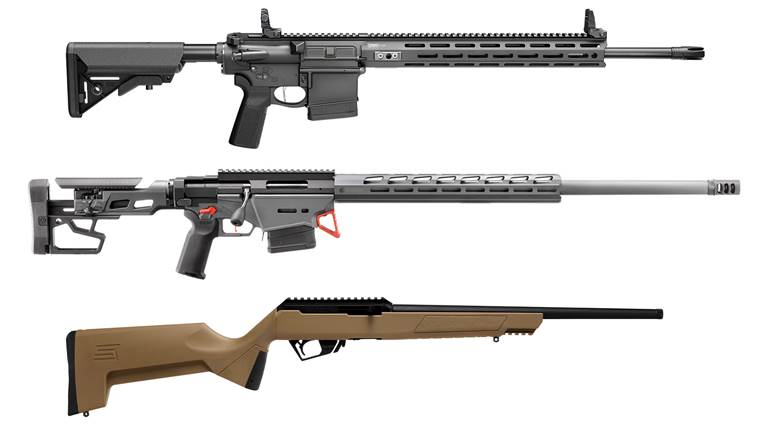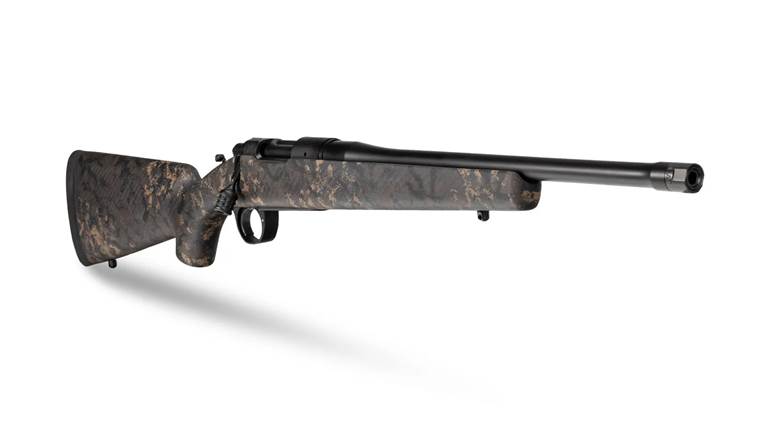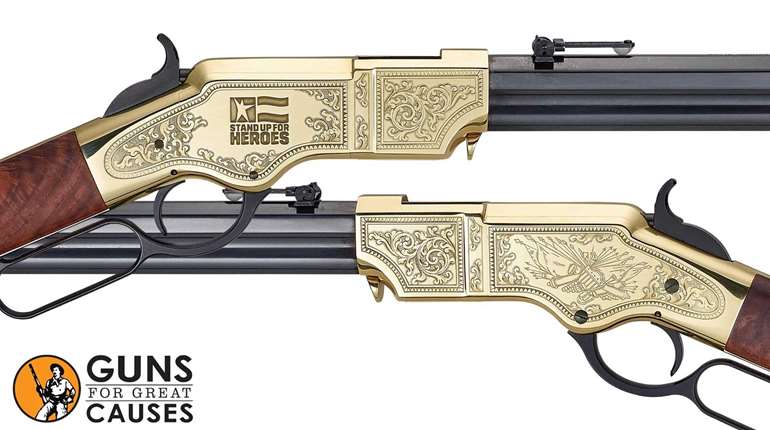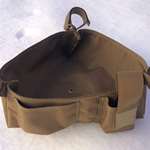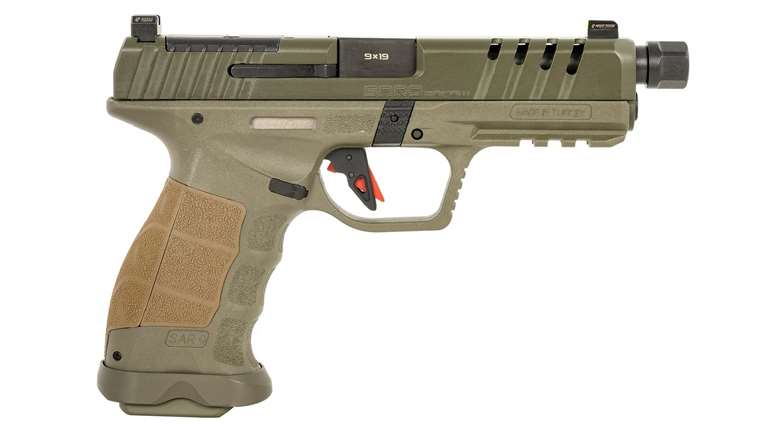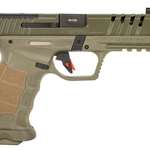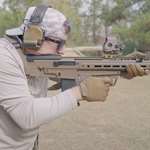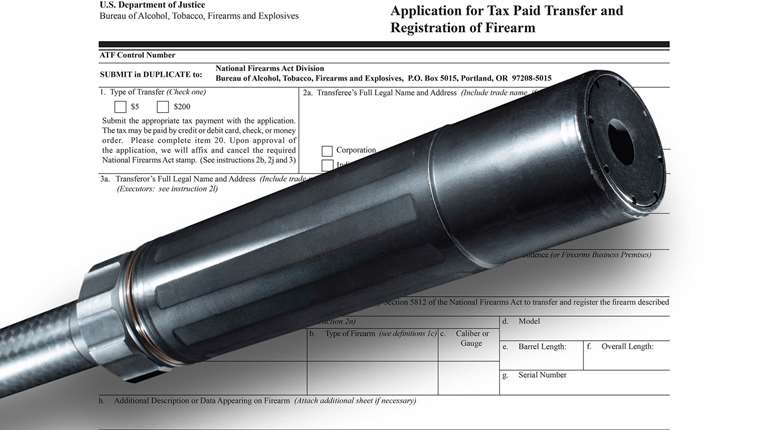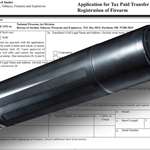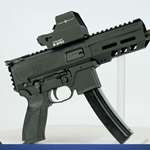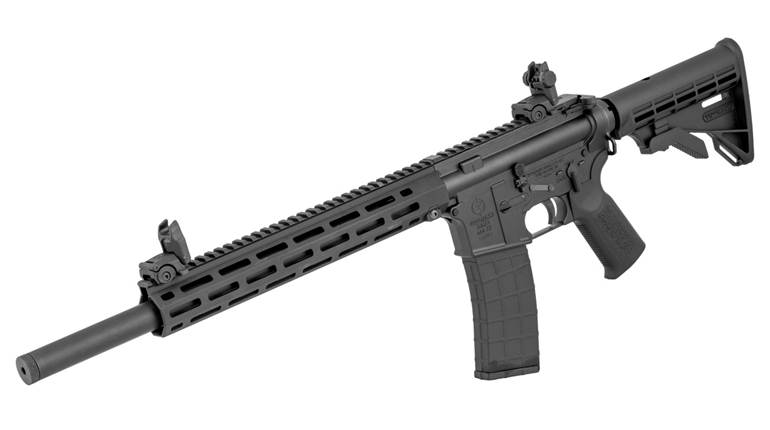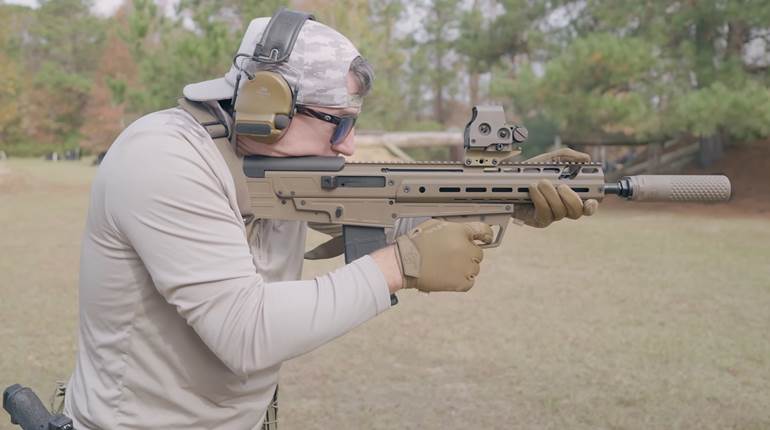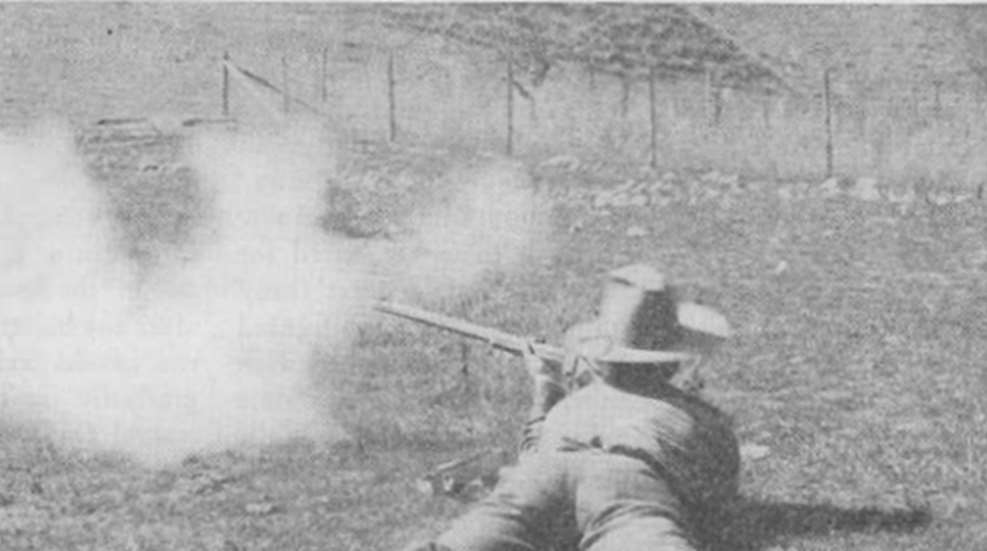
The following article was originally published in the June, 1940 issue of The American Rifleman.
For many years I have heard of the “Big Fifty” Sharps—ever since I was a very small boy wearing knee pants, blouse waist and a Windsor tie. Many old buffalo hunters in Montana told me of using or seeing them used on buffalo and other game during the seventies. As long as I lived in Montana and since then I have been watching for one, and had run down many clues only to find the result was either a .40 or .45 caliber side hammer Sharps Buffalo. Even these were very scarce and most of them long since picked up by collectors. Once in Helena I though I was going to get one. I did buy the Sharps outfit left by the old buffalo runner at his death—a great amount of .45 caliber 2 7/8” Berdan cases, some primers and a couple of ammunition cases for carrying the paper patched ammunition on the belt. Also some Sharps moulds in both .45 and .50 caliber paper patches. But of the rifles, never a trace, nor could the relatives say what had become of them.
At one time I owned forty Sharps side hammer rifles in calibers of .40, .44, and .45, using various length shells of both straight and bottle-neck persuasion, but in the whole lot there were just two of .50 caliber—a carbine altered from percussion tape lock and picked up on the Custer battlefield a few years after the fight, and a long light round barrel full stocked .50-70 Civil War sniper’s rifle with sling loops and peep and globe sights. Both these Sharps were single trigger and both really .52 caliber. I used the long sniper’s rifle a great deal, using heavy paper for my patches and patching that 473 grain slug so that it fitted tight in the fired case. It was very accurate for its light weight and I shot a good bit of game with it including one old mule deer.
After nearly thirty years’ search, I finally picked up two of the real old big fifty Sharps buffalo rifles in 16 pound weight with double set triggers and 30” octagon barrels. One of them I obtained from my old friend W.H. Lenneville, formerly of North Dakota. It takes a 3 ¼” straight case and was really overbored and is .52 caliber instead of .50. He had made a high comb heavy massive stock for the big weapon and added some lead under the buttplate to bring it to a fair balance and a weight of 21 pounds. The bore is pitted throughout, but the lands are deep and as far as the condition of the bore is concerned it should shoot as well as ever. The other big fifty is identical in every way except that it is a true fifty caliber and uses the .50-95-743 grain load with 2 1/2” straight case. Bore of this rifle is badly, almost hopelessly, pitted for over an inch at the muzzle and it would have to be shortened to 28” barrel length to ever make an accurate rifle of it. Balance of bore is in about the same condition as the gun taking the 3 ¼” case.
Both these Sharps are of course side hammer, and the first model after the percussion lock. Both are stamped on top flats of the heavy barrels “Sharps Rifle Manufg. Co. Hartford, Conn.,” the .50-95 in two lines and the .50-170-700 in one straight line. Both have the old silver-tipped fore-end typical of this model, and made before the Sharps Company adopted the slogan OLD RELIABLE that was stamped on the later model of side hammer Sharps. In fact, these are the rifles that established that trade name of Old Reliable. Both rifles have the regular long-range open sights, and I fitted a vernier long-range peep sight to the .50-170-700. As shown by the serial numbers, the .50-170-700 is the earlier made rifle. I have used several Sharps in .44-77-470 caliber of this same model, and one of them was formerly owned and used by Liver Eating Johnson. All had the same silver fore-end tip and none were stamped Old Reliable. All were Hartford Sharps, while the Old Reliable model seems nearly always to be stamped as made at Bridgeport, Conn.
The old buffalo hunters I talked with, and who are now gone to the Happy Hunting Ground, differed in their descriptions of the cartridge used by the big fifty, some claiming it was .50-95-473, and using a 2 ½” straight taper case, while a few others, including Waldo P. Abbot, were just as positive that it took at 3 ¼” straight taper case and a charge of 15 to 170 grains of powder and a 600 to 700 grain patch ball. Mr. Lenneville knew a man who had seen the .50-170-700 used on buffalo and who stated flatly it took a 3 ¼” case. Several years ago, I purchased a quantity of U.M.C. 3 ¼” straight big fifty cases of Mr. Lenneville. These established the fact beyond a shadow of a doubt that the big fifties were also made for this length of cartridge case. Lenneville and I each started looking anew for a rifle to handle them, and he was finally lucky in locating one. Strange to say, I got another, a duplicate, in .50-95 caliber from Jim Wade at the same time that Mr. Lenneville shipped me his big fifty. Previously I had seen a couple of 14-pound .50-95 Sharps of this model but these two are the only heavy 16 pounders I have ever seen in .50 caliber. Some of the lighter weapons were written up in The Rifleman some years ago.
From all accounts of the old timers who used or saw the big .50 caliber buffalo guns used, these accounted for more buffalo than all other guns together, a great many of the old timers making this statement. They also figured in a good many Indian fights the buffalo runners had with the various tribes while exterminating the buffalo. Some historians claim several were used in the famous Dobe Walls fight, where a little handful of hide hunters and skinners plus the complement of storekeepers at the post held off a vastly superior force of Indians for a couple of days of hot fighting. I can well imagine what the big fifty would do to both an Indian pony and his rider lying on the off side, as it would certainly penetrate both very easily.
To date I have put over 300 shots through this big fifty, using charges of from 150 to 170 grains of F.g. black powder. I soon found that the modern primers of non-mercuric persuasion did not seem to do as well as older primers. The 3 ¼” cases were of the Berdan primer type, it looks as if the Sharps Rifle Company must have later rechambered this big rifle to take the longer modern primer U.M.C. case; or else there were 3 ¼” Berdan cases in use. With all loads, extraction has been free and easy and very little swelling of the case has occurred even though all this shooting has been done with just 20 cases.
The groove diameter of the rifle mikes .525” just ahead of the chamber and has a short throat, while the groove diameter at the muzzle is just .519”. Evidently the bore tapers all the way from chamber to muzzle. Rifling is identical to the .50-95 except for larger groove diameter. Narrow, deep lands and wide grooves. This barrel has six lands making just about one full turn in the 30” barrel, minus the length of the chamber. The new cases are too small to receive a bullet large enough to fill the bore and must be fired first by seating a bullet in the throat ahead of the case and thus expanding them. Also, the mould received with the rifle is a solid one piece mould casting a tapering 700 grain slug, exact weight depending on temper of the metal. I like one to sixteen tin and lead for Sharps, but one must use harder metal for this rifle or rather this mould, otherwise in cutting off the sprue with the attached sprue cutter it pulls the base of the bullet away form the side of the mould and badly deforms the bullets. Further, after the bullet is cast and the sprue cut, you have to invert the mould and tap it gently with a stick of wood and gradually jar the slug down out of the mould onto several folds of cloth. This tapping in turn upsets small rings on the sides of the bullet, and I am positive I will never get best results from this rifle, or know just what it is really capable of, until I have Yankee Specialty Company make me a good two piece mould as they have for other Sharps calibers.
I tried different thickness patches of hard bond paper, finding that the .003” patch with two laps around the slug made a snug fit in the fired case and gave a measurement of .525” at the extreme heel or base of the bullet. Strangely enough, I obtained just as good groups from .002” patches that fitted very loosely, probably due to the fact that with a big charge of powder the bullet is upset well up into the lands.
I tried many ways of loading the big charges, pouring them through a long tube until they were settled deeply in the case, and also dumping them into the case through a shorter tube so that there was just enough room left for the heavy card wad over the powder, the disc of lubricant, and the seating of the patched slug about 1/16” to 1/8” in the case. In all tests, I got better accuracy with the slug just barely seated in the base (about 1/8”) than when it was deeply seated. This is exactly opposite to results with my old 18 pounds .45-100-566 Buffalo Sharps, as that rifle has a very long throat and the lands are beveled from the chamber up the bore for some distance and it shoots just as well with deeply seated bullets. Even when the bullets are seated one half inch in the case it gives fine accuracy. This rifle was formerly owned and used by Hank Waters, an old hide hunter, in Wyoming, Montana, and the Dakotas. Lenneville also made me a fine heavy high comb stock for it.
I tried several types of lubricant, from straight elk tallow to hard dry dental wax, also the formula by Col. Mayer. Got good groups with all types used, also some mighty bum groups as well. Sometimes I would get a promising group with four out of five shots cutting one another and then the next groups spread to three inches at 50 and 60 yards. In fact, every single time I thought I had the job licked and the proper load for the big gun that would be suitable for fine turkey match shooting, then the next group fired with same load and same careful holding would utterly shatter my hopes.
I believe this bullet is very close to the maximum weight this twist will spin accurately. Several times when I loaded as much as a half inch of lubricant behind the bullet, the groups always spread badly and best results were usually secured with a couple or three thicknesses of hard dental wax, or Sisk lubricant put up from the .22 caliber high velocity center fire loads. In fact I believe this Sisk graphite lubricant, about three thicknesses, is about as good as any. However, the hard dental wax seems to shoot just as well, and softer lubricant in greater quantities always spreads my groups.
I believe it was Colonel Mayer who wrote that Sharps rifles with deep lands were not suitable for paper patch loads, and certainly the Sharps Company bored all their later barrels with wide shallow lands. However, the two most accurate Sharps I have ever owned were cut with wide, deep, and heavy lands. One was a .40-90 bottleneck throwing the 370 grain patch bullet, and the other my present .45-100-566. A Sharps paper patch must absolutely whirl off the bullet at the muzzle or be slit along its length by the lands until it leaves the bullet at the muzzle, or it will be inaccurate. I have noticed that the fired patches were always found in strips the width of the grooves in front of the gun after firing, regardless of whether I used a Sharps with wide very shallow lands or one with deep lands. So for me at least the shallow land barrels have not proved superior in any way.
I recovered a great many fired bullets and these also told their tale and how to correct it. Powder used was Laflin & Rand Orange Extra, and the dullest, dirtiest black powder I have ever found to date. Years ago in Montana, I used to use this same brand exclusively and it was always bright and shiny, with hard grains and very clean. When I fired five shots straight without cleaning, the recovered bullets showed conclusively that the powder caking in the throat had cut grooves full length of the bullets and had caused some stripping of the patches as clearly shown by the impression of where they had been wrung around the soft slug in passage up the bore. Cleaning after each shot with a wet patch cured this trouble.
With some powders and Sharps rifles I have fired a dozen shots in succession without cleaning and without the accuracy suffering, but this seems largely dependent on both powder used and also on the lubricant. In turkey match work with the .45-100, I always wiped the bore clean and dry between shots. These recovered bullets fired through the target, thence into two feet of soft snow are unmarred in any way, except by the lands of the gun and clearly show the length of patch needed. These big slugs would travel a long way through the soft snow, and by next day after snow had frozen some during the night, could be easily traced by a hard frozen trail in the snow some two inches in diameter. Some went down to the ground, then ricocheted up over a mountain, making a weird sound like a Stokes mortar in miniature. The mule deer wintering on this mountain paid little or no attention to my firing modern rifles over this range, but the roar of the big Sharps, and the occasional ricochet, soon bounced them all over the mountain out of sight.
I have never found so good a medium as soft snow for catching bullets unmarred, to determine just how well they upset and fill the grooves and how the patch of Sharps bullets is standing up to its work. What you do not find at the time can be picked up in the spring when the snow melts, and they will tell their tales. One group fired with this big fifty put four shots touching each other, and then the fifth shot went wild. I saw this slug ricochet and throw up snow again at the foot of the mountain, so went over and found it. It had a big air hole in one side I had not noticed in patching it. This group would very probably have all cut into each other but for that one bum slug. But to date after working with the big gun at every opportunity most of the winter I have not yet gotten a really good group comparable to the work of my .45-100-566 Sharps Buffalo. In every case when I got a promise, four shots would cut close together and the fifth would wander off. The groups sent with this article tell the tale and are the best groups obtained. For each good one, I have fired many bum ones, with the same load. The grouping is not consistent through the rifle shows no changing point of impact. After all this firing I am convinced the trouble lies with this one piece mould, and the bullet may be about 50 grains heavy for this twist. If any old timer readers this who used these big rifles, I would like to know just what weight bullets he used. I feel sure the rifle will do better than any group I have made with it, but think a new mould is the only solution.
All groups were fired from bench rest, or prone with muzzle and elbow rest. Recoil is not bad, thought it is a darn heavy jar at that; but the report, when the muzzle does not quite project outside this log cabin I shoot from in bad weather, is something to be remembered. I have had to plug my ears to stand it. Outside, with some other shooter firing, it sounds like a miniature one pounder going by and the big slug has a distinct sharp ping, the same as a high power rifle bullet. So far the 165 to 170 grain loads seem to do as well as any lighter loads, and the slow twist probably needs all the speed I can give this slug for proper stabilizing of such a heavy bullet.
I have not seen any evidence of the base of the patch and the card wad and lubricant discs adhering to the base of the bullet and thus causing a flier as so often occurs with hollow base factory loaded Sharps bullets, or hollow base bullets from many of the original Sharps rifle Company moulds. I have found not bullet as yet with any portion of patch or lubricant stuck to its stern. With all hollow base Sharps patch bullets, and particularly the prettiest type of all—the 550 grain factory .45 caliber bullet of either Winchester or U.M.C. make, I have found many slugs in the snow with the tail of the patch curled up in that hollow base and sometimes the lubricant wad and the heavy card wad all driven into and adhering to the base of the bullet. Needless to say, this always causes fliers with any Sharps. I have often loaded these bullets with about five grains of Cream of Wheat cereal next the bullet to prevent the lubricant from driving into the hollow base and sticking there.
Patches must be cut just the right shape, and to install them on the bullet I hold the point of the bullet with the left forefinger and thumb, then wet the patch and lay on the bullet with the long point toward me, then, turning the bullet toward me, roll the patch tightly on the slug. Next I twist the resultant end, and curl it up on the base, or if a hollow base bullet push the curled and twisted end of the patch down into the cavity of the base. Then I let it dry thoroughly, and if a flat base slug, take sharp shears and clip off the patch as short as possible. After firing and recovering the big slug, you will always find the delicate pattern or tracery made by the powder charge and lubricant driving any and all tiny wrinkles and folds of the patch on the base into the metal itself. This is so shallow as to cause no harm, but if you leave the tail of the patch that you twisted and curled up on the base without clipping off, it will always cause a deep dent in the bullet base from pressure, and of course is a detriment to fine accuracy.
Though I have killed elk and deer with .45 and .44 caliber Sharps I have not fired this rifle at game, but it certainly should be a killer. From the sound of the bullet passing you, also the powder charge and the bullet weight, I would estimate the velocity to be around 1500 feet. Using the pounds-feet formula I have described in the Rifleman, it becomes the most powerful sporting cartridge every made and used in America, to my knowledge. If said velocity is 1500 feet as estimated, then the big gun would develop 150 pounds-feet of energy or the same as the British 470 Express Cordite cartridge with 500 grain bullet at 2100 feet. I know if I had to stop a big Alaskan Brownie with just one shot, and my life depended on it, I would rather bust him in the chest with this big gun than with any modern American load. This gun and cartridge prove definitely that the old timers who demanded and made such a gun possible knew what it took for clean one shot kills on our American bison, and while black powder will somewhat obscure your game after firing and these loads like all other black powder loads have a high trajectory, nevertheless the old buffalo hunters knew what was needed far better than any hunters of today, and as a class were probably the most skilled game shots of all time.
I fired the big fifty at two straight grain yellow pine blocks, each block 18” thick and set end to end. The 700 grain slug went through both at each shot, so I don’t know yet how many it would take to stop it. It is to me one of the most interested truly American rifles and loads.












